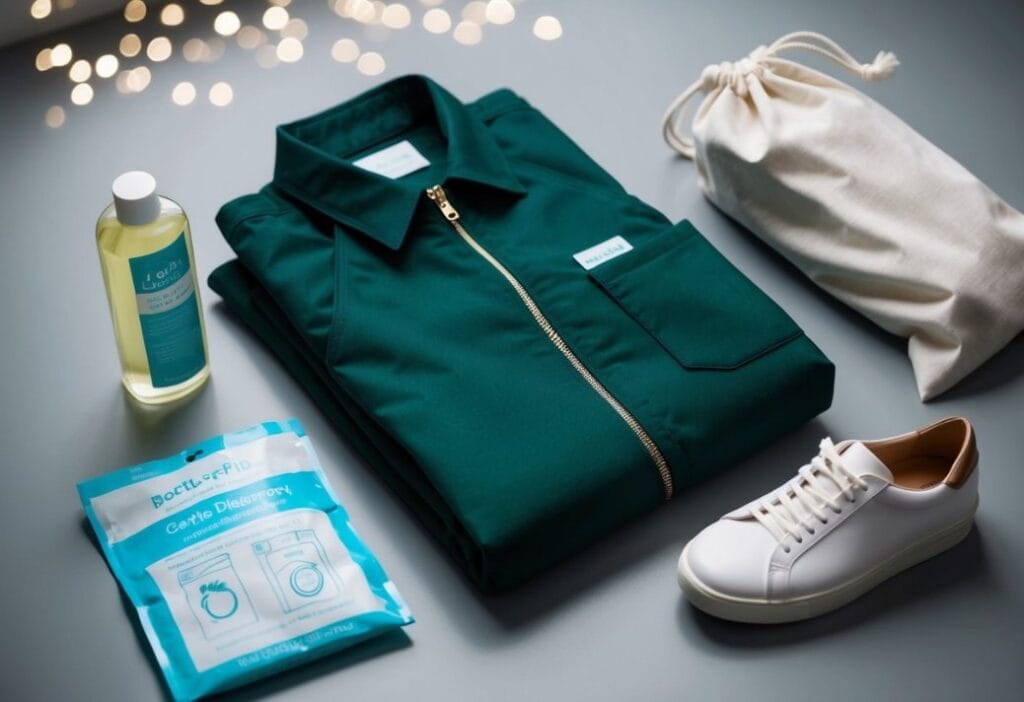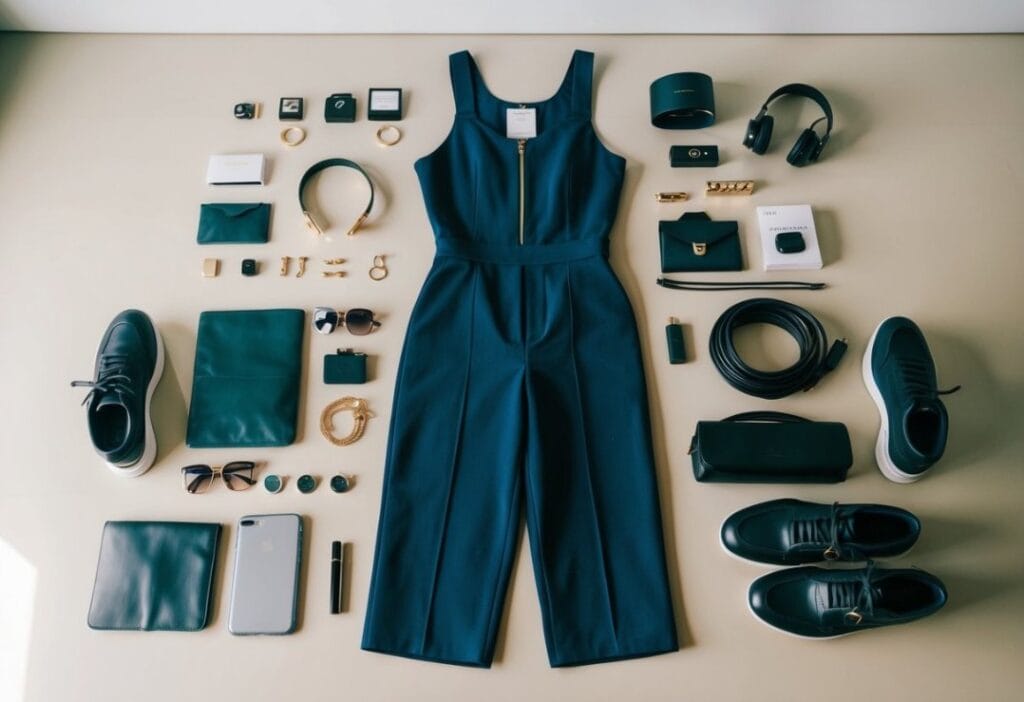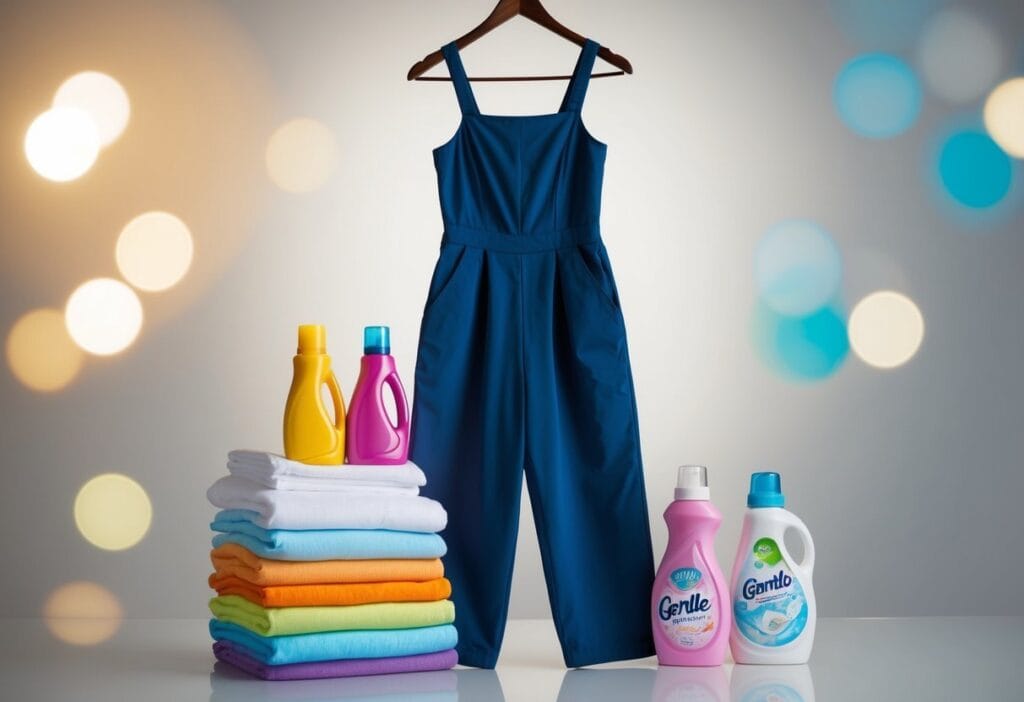Jumpsuits are a versatile and stylish clothing option for women. They can be worn for casual outings or dressed up for formal events. Taking good care of your jumpsuit is key to keeping it looking great.
To care for a women’s jumpsuit, wash it gently using cold water and mild detergent. I always check the care label first, as some jumpsuits may need special treatment. For delicate fabrics, hand washing is often best. After washing, I reshape the jumpsuit if needed and hang it to dry. This helps prevent shrinkage and keeps the fabric in good condition.
Proper storage is also important. I like to hang my jumpsuits on padded hangers to avoid creases. For travel, I fold them carefully and place tissue paper between the folds to reduce wrinkles. With these simple steps, my jumpsuits stay looking fresh and ready to wear.
Table of Contents
Key Takeaways
- Wash jumpsuits in cold water with mild detergent
- Hang jumpsuits to dry and reshape if needed
- Store jumpsuits on padded hangers or fold with tissue paper
Understanding Women’s Jumpsuits

Jumpsuits are versatile one-piece garments that combine a top and bottom. They come in many styles and can be worn for different occasions. Let’s explore the types of jumpsuits and their role as adaptive clothing.
Types of Jumpsuits
I’ve seen many jumpsuit styles for women. Casual jumpsuits are comfy and great for everyday wear. They often have loose fits and soft fabrics. Dressy jumpsuits work well for formal events. These usually have tailored cuts and fancier materials.
Some jumpsuits have short sleeves or are sleeveless. Others have long sleeves for cooler weather. Leg lengths vary too. You can find short jumpsuits, called rompers, or full-length options.
I’ve noticed jumpsuits with different waist styles. Some have elastic waists for a relaxed fit. Others use belts or ties to create shape. There are also fitted jumpsuits that hug your curves.
Significance of Adaptive Clothing for Dementia Patients
Adaptive clothing helps people with dementia dress more easily. Anti-strip jumpsuits are a type of adaptive clothing. They stop patients from removing clothes at wrong times.
These special jumpsuits have back zippers or closures. This makes it hard for patients to take them off alone. The fabric is often soft and stretchy for comfort.
I’ve learned that adaptive jumpsuits can reduce stress for caregivers. They don’t have to worry as much about patients undressing. This clothing also helps maintain dignity for dementia patients.
Adaptive jumpsuits come in different styles. Some look like regular clothes. This helps patients feel more normal. The jumpsuits can be worn day or night for full-time care.
Important Features of Jumpsuits

Jumpsuits have key features that make them comfortable and practical. The right fabric and design choices can make a big difference in how easy they are to wear and care for.
Fabric Choices for Comfort and Durability
Quality fabric is key for a good jumpsuit. I like soft, stretchy materials that move with my body. Cotton blends are comfy and breathable for everyday wear. For dressy events, I pick silk or polyester jumpsuits.
Durable fabrics are important too. I look for rip-resistant bodysuits that can stand up to lots of wear. Some jumpsuits have reinforced seams in high-stress areas.
For easy care, I choose wrinkle-resistant fabrics. These need less ironing and stay neat all day. Moisture-wicking materials are great for hot weather or workouts.
Design Elements for Assisted Dressing
Smart design makes jumpsuits easier to put on and take off. A back zipper is a must-have feature for me. It lets me zip myself up without help.
For those who need extra help, there are jumpsuits made as adaptive clothing. These have special closures like magnetic snaps or velcro. They’re easier to use for people with limited mobility.
Some jumpsuits have wrap-style tops. These are simple to put on and adjust. Elastic waists are another handy feature. They let me pull the jumpsuit on over my head.
Jumpsuit Care and Maintenance

Taking good care of your jumpsuit keeps it looking great and lasting longer. Here are some tips for washing, drying, and maintaining your favorite one-piece outfit.
Washing and Drying Best Practices
I always check the care label first. Most jumpsuits can be machine washed in cold water. I use a mild detergent and close all zippers and buttons before washing. For delicate fabrics, I hand wash in cool water with gentle soap.
After washing, I reshape the jumpsuit if needed. I hang it to air dry or use the dryer on low heat. I take it out while still slightly damp to prevent shrinking.
For stubborn stains, I spot clean gently. I avoid scrubbing hard, which can damage the fabric. Soaking for 30 minutes max usually does the trick.
Extending the Life of Your Jumpsuit
I store my jumpsuits on padded hangers to keep their shape. For long-term storage, I use a garment bag to protect from dust.
I steam or iron on low heat to remove wrinkles. For tricky fabrics, I use a pressing cloth.
Between wears, I air out my jumpsuit. This helps it stay fresh longer. I also treat stains right away to prevent setting.
For repairs, I take my jumpsuit to a pro. Small fixes now can prevent bigger issues later.
Accessorizing and Layering

Jumpsuits can be styled for different occasions with the right accessories and layers. I’ll share some tips on pairing outerwear and choosing undergarments to elevate your jumpsuit look.
Coordinating with Outerwear
I find that jackets are great for adding warmth and style to jumpsuits. A fitted blazer can make a casual jumpsuit work-appropriate. For chilly days, I like to throw on a leather jacket or denim jacket for an edgy vibe.
Capes are another fun option. They add drama and keep you cozy. I prefer shorter capes that hit at the waist to keep the jumpsuit’s shape visible.
In winter, I go for longer coats. A belted trench or wool coat looks sleek over a slim-fit jumpsuit. Puffer jackets work well with looser styles for a more casual look.
Choosing the Right Underwear and Leg Wear
Seamless underwear is key with jumpsuits. I opt for thongs or boyshorts to avoid visible panty lines. For extra smoothing, bodysuits can work wonders under fitted jumpsuits.
Bras can be tricky. Strapless or convertible bras are good for sleeveless styles. For jumpsuits with plunging necklines, I use adhesive bras or bra tape.
Leg wear depends on the jumpsuit length and season. With cropped jumpsuits, I like ankle socks or no-show socks. For full-length styles, I might wear tights or leggings in colder months.
Sheer or textured tights can add interest to solid-colored jumpsuits. In summer, bare legs are my go-to for a fresh look.
Building Confidence with the Right Jumpsuit

I’ve found that wearing a jumpsuit can be a real confidence booster. The key is finding one that fits well and makes you feel great. Here are some tips I’ve learned:
Choose a jumpsuit that flatters your body shape. A well-fitted jumpsuit can enhance your best features and make you feel amazing.
Pick a style that suits your personality. Whether it’s bold and colorful or sleek and simple, the right jumpsuit should reflect who you are.
Don’t be afraid to try different cuts and fabrics. Some jumpsuits have wider legs or elastic waists that can be more comfortable and flattering.
Accessorize to make the look your own. Adding a belt, jewelry, or fun shoes can really boost your confidence.
For those with adaptive clothing needs, look for jumpsuits with easy-access features like side zippers or magnetic closures.
Remember, confidence comes from feeling comfortable and true to yourself. If a jumpsuit makes you feel awkward, it’s not the right one for you.
Try on several options before deciding. Take photos to see how they look from different angles.
Ask for honest opinions from friends or family if you’re unsure. Sometimes a second opinion can help you see yourself in a new light.
With the right jumpsuit, you’ll feel ready to take on the world. It’s all about finding that perfect match for your style and body.

